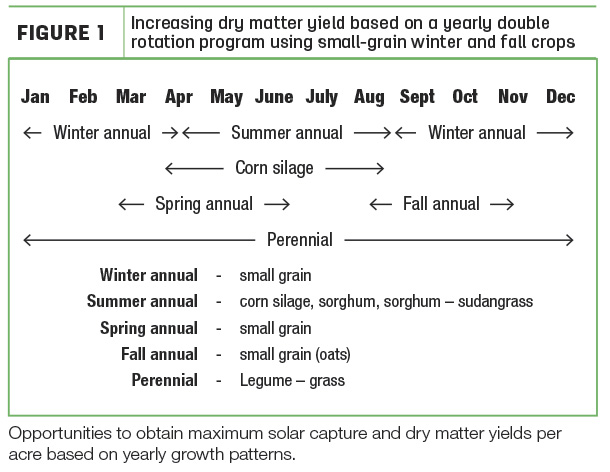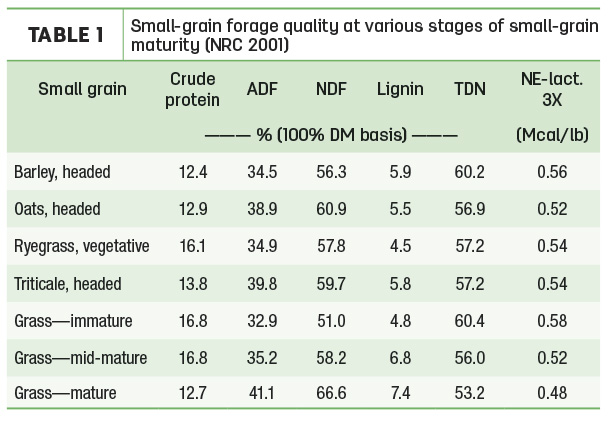Small-grain forages should be considered as a win-win situation. Dairy farmers “win” as a cover crop, early spring or fall source of forages, decrease in soil erosion, an opportunity to incorporate manure in late spring and early fall, and extending the growing season capturing more solar energy per acre.
Environmentalists and consumers “win” as less nutrients are lost due to water runoff, less soil losses and improved soil health. Several questions can be raised by dairy farmers. One recommendation is to try limited acreage to evaluate your responses, cow response to the forage and impact on spring and fall time demands.
Why should I consider small-grain forages in my cropping rotation?
The ability to double crop your acreage can increase total forage dry matter (DM) yield per acre. Figure 1 illustrates how small-grain forages fill in the year timetable opportunities raising more forage DM.

More solar light is captured as a forage resource, removing excessive soil nutrients, retaining moisture and could have value as a carbon credit in the future. The decision on when to harvest can depend on current forage inventory and needs for the year. Small-grain forages grow when adequate winter and spring moisture are available, reducing drought risks to summer annuals (such as corn silage) or perennials (legume and grass forages).
Which crops can be considered?
Two factors enter in your decision. Winter annuals must by planted in late August to early September to allow adequate growth before winter dormancy occurs. If the forage gets too tall, the small-grain forage can smother and lead to winter snow mold. Small-grain forages can be high in potassium (over 3% potassium) depending on soil levels, which can limit small-grain levels in close-up dry cow rations, raising dietary cation - anion difference (DCAD) levels. Small-grain crops are listed below, including data and comments from Michigan State workers.
- Winter wheat is a traditional small-grain forage. It is popular when harvested as grain and straw followed with soybeans. Dairy farmers have two choices with winter wheat: Harvest as a forage source planting full-season corn silage or allow wheat to mature, harvesting as wheat grain (projected at $5.50 a bushel – USDA 2021) and wheat straw (used as a feed source for dry cows, older heifers or bedding valued from $100 to $150 a ton).
- Winter triticale (a hybrid cross of wheat and rye) is gaining in popularity due to higher yields and quality along with enhanced palatability. It is well suited for all soil types, including sandy soil. Seeding rates range from 90 to 120 pounds per acre.
- Winter rye is a popular small-grain forage, as it is a crop that can handle moisture and is the most cold-tolerant small grain. Quality and palatability can drop as maturity occurs. Seeding rate is 90 to 100 pounds per acre.
- Winter barley is raised in Canada and northern areas of the U.S. Tonnage as forage DM is less than oats and triticale. It is an early maturing, winter small-grain crop. The crop does best in well-drained soil. Suggested planting rate is 120 to 150 pounds per acre.
- Spring oats is a nurse crop used to establish legumes, primarily alfalfa. The oat crop should be harvested in the flag to boot stage, allowing the alfalfa to flourish and not compete for limited moisture and nutrients with oats. Harvested in the boot stage, a second regrowth can occur as the oat-growing point is able to grow. This second growth is minimal and lower in quality, as the next harvest is based on the stage of growth of the legume. If the oat forage is being used as a nurse crop, reduce the seeding rate in half.
- Spring barley and wheat are planted when soil temperatures and moisture allow. It can be planted as a traditional crop harvested in mid-summer.
- Fall oats can be planted after early corn silage harvest. Target planting in late August to early September, allowing adequate daylight and length for optimal growth. Harvest is typically 60 days after planting depending on plant maturity and growing conditions. The oat crop will be high in moisture content and cannot be made into hay, as dry conditions are marginal, requiring extended drying days and sunlight. Wisconsin workers suggest planting forage oat varieties with higher DM yields compared to fall wheat.
When can small-grain forages be harvested?
This decision will vary from farm to farm. If you need high-quality forage (NDFD over 60%) for lactating cows, you will want to harvest in the flag to boot stage (head starting to emerge from the stem or sheath). In addition to high NDFD, total aNDFom can be under 50% and CP over 15% (depending on soil nitrogen level). There are two challenges to consider with boot-stage harvest maturity. First, the DM content can be under 30%, requiring wilting of the small-grain crop. Second, the optimal harvest window can be limited to three to five days, capturing high quality. Rain can delay the wilting and harvest time by 10 days or more, leading to lower quality and/or damaged forage. The yield of boot-stage small grain can vary from 1 to 2 tons of DM per acre.
Harvesting small grain in the milk to dough stage (seedhead has emerged and will have a milk to dough consistency in the seed), the quality of the small grain becomes more straw-like, with NDFD dropping below 50%, aNDFom over 60% and CP from 10% to 12%. Two advantages include DM yield per acre, which can double to 3 to 5 tons, and the late-cut small-grain forage can be over 30% DM, allowing for direct harvest. Position lower-quality, small-grain forage to replace straw (in dry cow or lactating cow rations), a forage extender in older heifer rations (need to dilute down higher-quality forages when fed free-choice) and to limit and control dry matter intake (DMI). Small-grain silage will have been chopped, reducing forage particles to be added directly in TMRs without further processing needed with dry straw. Chopping guidelines include 3/8- to 1/2-inch theoretical length of chop (TLC) with no forage particles over 1 inch in length (using the three-box Penn State Particle Separator with a distribution of 33% in each box on a wet basis).
What nutrient levels can I expect among various small-grain forages?
Small-grain forages can be similar at the same stage of maturity. Nutrient values for small-grain forages are listed in Table 1.

CP content reflects higher-quality small-grain forages. Acid detergent fiber (ADF), NDF and lignin levels reflect maturity. Energy contents expressed as TDN or net energy-lactation at three times maintenance reflect maturity impact. The grass listed in NRC 2001 is mainly ryegrass but could include other grasses. Maturity changes can be monitored and compared to the listed small-grain sources in Table 1.
What agronomic considerations may be needed?
Small-grain forages will require nutrients for optimal growth. Manure applications can be a source of nitrogen when seeding in the fall and following spring growth. Penn State workers suggest 100 pounds of nitrogen (half as manure – slower release of nitrogen – and half as commercial fertilizer – releases the nitrogen at a quicker rate). If additional soil nutrients following small-grain harvest in the same year are not applied, Wisconsin researchers reported a 13% yield reduction in the subsequent corn crop in the same year. Two tons of small-grain DM removes 90 pounds of nitrogen, 30 pounds of phosphorus as P2O5 and 155 pounds of K2O. Harvesting the small-grain forage in the boot stage allows for earlier planting of corn for corn silage, early fall harvesting of the corn silage and planting of the fall/winter small-grain for the next crop year. If the cover crop is chemically killed and or incorporated in the soil, nutrients are not removed from the soil (role of small grain as a cover crop.).
Can small-grain crops be a cover crop?
Small-grain winter crops can be an excellent cover crop. In some areas, farmers may be paid a small stipend to plant a winter cover crop for the following reasons.
- Soil erosion control
- Allow for water infiltration in the soil versus runoff
- Build soil health when incorporated back in the soil, reducing compaction due to root growth
- Capture of nitrogen and phosphorus in plant material rather than risk runoff
- Nitrogen production when planting legumes
- Control weeds
An example of a cover crop as a soil builder could include 67% triticale, 11% crimson clover, 10% hairy vetch, 10% annual ryegrass and 2% radish seed.







